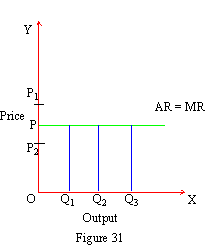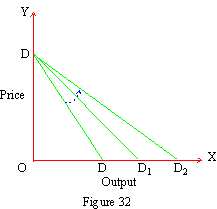|
(C) Analytical Gains: The analytical outcome of a competitive market is derived from the six characteristics of competition. Thus, analytically, Price Uniformity and Horizontal Demand Curve, and Normal Profits are the attributes of competition.
i) Uniform Prices: In a competitive market, an individual firm has no capacity to influence market conditions. Therefore it has to take market price as given, constant and uniform in nature. The price of a good is also known as the Average Revenue of the firm.

This is because Total Revenue of a firm is Price (P) ī Output (Q) sold. Hence, Price is Total Revenue divided by Quantity Sold which is Average Revenue.
TR = P ī Q, hence
TR = P = Average Revenue
Q
Since Average Revenue or Price and Marginal Revenue are identical, when the former is constant the latter is also constant. Moreover, the Average Revenue curve of a firm is the same as the individual demand curve. Hence, the competitive demand curve is a horizontal straight line parallel to the OX axis. This has been shown in Figure 31. The quantity of Output produced and sold is shown on the OX axis and Price is measured along the OY axis. Competitive market price OP is given and fixed for an individual firm. At this price the firm has freedom to produce any small or large quantity such as Q1, Q2, Q3 etc. The firm cannot charge a higher or lower price than the OP. If it attempts to charge a somewhat higher price like OP1 assuming competition, the firm will be able to sell nothing. On the other hand, if it charges a somewhat lower price OP2 the firm will unnecessarily suffer losses.

ii) Horizontal Demand Curve: With constant market price an individual firmís demand curve is perfectly flexible. It assumes the form of a horizontal straight line. Such a demand curve is also the Average and Marginal Revenue curve of a firm. In Figure 31, P - AR = MR is the demand curve of a firm. Earlier we studied the nature of a demand curve which is downward sloping. In a competitive market as well, there is a downward sloping demand curve. It is applicable to the entire market or the industry. Such a demand curve has been shown as DD in Figure 32.
The relation between a firmís demand curve and market demand curve can be explained in two ways. When there are innumerable firms under competition each firmís demand quantity appears as a dot or a point (f1, f2...fn) on the market demand curve. Again with each addition of a firm to the market the industry demand curve becomes more flexible; structurally it gets flatter. It starts moving in the direction of DD ® DD1 ® DD2 and ultimately assumes the form of a horizontal straight line. Therefore there is no contradiction between the horizontal demand curve of a firm and the downward sloping demand curve of a market or industry.
iii) Normal Profits and Price Takers: Finally, though the price is fixed and a firm has to accept it as given, such price ensures normal profits for the firm. These profits are economic profits and enable a firm to cover all its explicit and implicit costs. In the short run more efficient firms may make Super Normal profits but these will not continue in the long run. On the other hand, if some firms are suffering Sub Normal profits or losses they will have to quit or exit and discontinue production in the long run. All firms in a competitive market make only normal profits in the long run. Because of fixed and uniform price and normal price conditions, individual firms are called Price Takers. They have to accept the market price as given. Therefore, they are not Price Makers.
[next page]
|